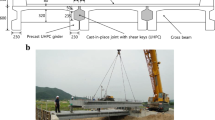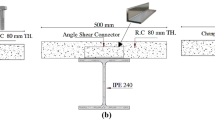Abstract
Currently, shear transfer models have diverse assumptions about the contribution of shear reinforcements and concrete to the shear capacity of interfaces between concretes cast at different times (that is, cold joints). Furthermore, the knowledge about the effect of high-strength shear reinforcements (HSSR) having a nominal yield strength exceeding 414 MPa (60 ksi), is still limited. This study aims to determine the extent to which shear reinforcements and concrete contribute to the shear capacity of cold joints and explore the effect of HSSR on shear transfer behavior. To this end, nine cold joint push-off specimens were tested to investigate the effects of yield strength of shear reinforcement (YSSR) and concrete compressive strength (CCS) on the interface shear strength and stiffness. In addition, code provisions evaluation was used to identify the degree of concrete contribution, based on a database of 108 cold joint push-off test results established in this study. Test results indicate that the increase of YSSR (rising from 400 MPa to 600 MPa) has no evident effect on the shear strength and stiffness of cold joints, whereas the increase of CCS can significantly increase them. Moreover, when CCS rises from 20 MPa to 50 MPa, the interface shear capacity of push-off specimens increases by approximately 110%, i.e., from 103.5 kN to 217.5 kN. Hence, concrete has a considerable contribution, whereas the contribution of shear reinforcements is not as great as expected. Code provisions evaluation results also indicate that concrete considerably contributes to the shear capacity in the form of cohesion. On the basis of these findings and current design equations, a shear capacity equation, which accounts for the effect of CCS and the limited participation of shear reinforcements, is proposed. This equation is found to provide reasonable prediction of cold joint shear capacity, especially for the cold joint composed of high-strength concrete.
Similar content being viewed by others
References
AASHTO (2017) AASHTO bridge design specifications, 8th edition. American Association of State Highway and Transportation Officials, Washington DC, USA
ACI 318 (1977) ACI 318–77: Building code requirements for structural concrete. ACI 318–77, American Concrete Institute, Farmington Hills, MI, USA
ACI 318 (2019) ACI 318–19: Building code requirements for structural concrete. ACI 318–19, American Concrete Institute, Farmington Hills, MI, USA
Barbosa AR, Trejo D, Nielson D (2017) Effect of high-strength reinforcement steel on shear friction behavior. Journal of Bridge Engineering 22(8):04017038, DOI: https://doi.org/10.1061/(ASCE)BE.1943-5592.0001015
Birkeland PW, Birkeland HW (1966) Connections in precast concrete construction. ACI Journal Proceedings 63(3):345–368
CAN/CSA-S6-00 (2000) CAN/CSA-S6-00: Canadian highway bridge design code. Canadian Standards Association, Toronto, ON, Canada
Figueira D, Sousa C, Calçada R, Neves AS (2015) Push-off tests in the study of cyclic behavior of interfaces between concretes cast at different times. Journal of Structure Engineering 142(1):0401510, DOI: https://doi.org/10.1061/(ASCE)ST.1943-541X.0001364
Harries KA, Zeno G, Shahrooz B (2012) Toward an improved understanding of shear friction behavior. ACI Structural Journal 109(6):835–844
Jiang H, Fang Z, Ma ZJ, Fang X, Jiang Z (2016) Shear-friction behavior of groove interface in concrete bridge rehabilitation. Journal of Bridge Engineering 21(11):04016081, DOI: https://doi.org/10.1061/(ASCE)BE.1943-5592.0000953
Kahn LF, Mitchell AD (2002) Shear friction test with high-strength concrete. ACI Structural Journal 99(1):98–103
Kono S, Tanaka H (2000) Interface shear transfer for high strength concrete and high strength reinforcement. 12th World Conference on Earthquake Engineering, Upper Hutt, New Zeland, 0641
Kono S, Tanaka H, Watanabe F (2001) Interface shear transfer for high strength concrete and high strength shear friction reinforcement. International conference on high performance materials in bridges, July 29-August 3, Kona, HI, USA, 319–328
Liu J, Fan JX, Chen JJ, Xu G (2019) Evaluation of design provisions for interface shear transfer between concretes cast at different times. Journal of Bridge Engineering 24(6):06019002, DOI: https://doi.org/10.1061/(ASCE)BE.1943-5592.0001393
Loov RE, Patnaik AK (1994) Horizontal shear strength of composite concrete beams with a rough interface. PCI Journal 38(1):48–69
Mansur MA, Vinayagam T, Tan KH (2008) Shear transfer across a crack in reinforced high-strength concrete. Journal of Materials in Civil Engineering 20(4):294–302, DOI: https://doi.org/10.1061/(ASCE)0899-1561(2008)20:4(294)
Mattock AH (1976) Shear transfer under monotonic loading across an interface between concretes cast at different times. Rep. SM 76-3, Department of Civil Engineering, University of Washington, Seattle, WA, USA
Mattock AH (1994) Reader comments: Horizontal shear strength of composite concrete beams with a rough interface. PCI Journal 39(5):106–108
Mattock AH (2001) Shear friction and high-strength concrete. ACI Structural Journal 98(1):50–59
Mattock AH (2013) Toward an improved understanding of shear-friction behavior. ACI Structural Journal 110(5):890–891
Rahal KN, Khaleefi AL, Al-Sanee A (2016) An experimental investigation of shear-transfer strength of normal and high strength self compacting concrete. Engineering Structures 10:16–25, DOI: https://doi.org/10.1016/j.engstruct.2015.11.015
Semendary AA, Hamid WK, Steinberg EP, Khoury I (2020) Shear friction performance between high strength concrete (HSC) and ultra high performance concrete (UHPC) for bridge connection applications. Engineering Structures 205:110122, DOI: https://doi.org/10.1016/j.engstruct.2019.110122
Shaw D, Sneed LH (2014) Interface shear transfer of lightweight-aggregate concretes cast at different times. PCI Journal 59(3):130–144
Walraven J, Frenay J, Pruijssers A (1987) Influence of concrete strength and load history on the shear friction capacity of concrete members. PCI Journal 32(1):66–84
Walraven J, Reinhardt H (1981) Theory and experiments on the mechanical behaviour of cracks in plain and reinforced concrete subject to shear loading. Heron 26(1A):1–68
Williams CS, Massey JB, Bayrak O, Jirsa JO (2017) Investigation of interface shear transfer using push-through tests. ACI Structural Journal 114(1):173–185
Xiao J, Sun C, Lange DA (2016) Effect of joint interface conditions on shear transfer behavior of recycled aggregate concrete. Construction and Building Materials 105:343–355, DOI: https://doi.org/10.1016/j.conbuildmat.2015.12.015
Zilch K, Reinecke R (2000) Capacity of shear joints between high strength precast elements and normal-strength cast-in-place decks. PCI/FHWA/FIB international symposium on high performance concrete, September 25–27, Orlando, FL, USA, 551–560
Acknowledgments
The authors wish to acknowledge the financial support from National Natural Science Foundation of China (Grant No. 51641807), Natural Science Foundation of Hubei Province (Grant No. 2018CFB664), and Open Research Fund Project of Hubei Key Laboratory of Disaster Prevention and Mitigation (China Three Gorges University) (Grant No. 2018KJZ06). The authors also thank Zhongguo John Ma from University of Tennessee, Knoxville, TN, United States, for his valuable suggestions.
Author information
Authors and Affiliations
Corresponding author
Rights and permissions
About this article
Cite this article
Liu, J., Bu, Y., Chen, J. et al. Contribution of Shear Reinforcements and Concrete to the Shear Capacity of Interfaces between Concretes Cast at Different Times. KSCE J Civ Eng 25, 2065–2077 (2021). https://doi.org/10.1007/s12205-021-0791-5
Received:
Revised:
Accepted:
Published:
Issue Date:
DOI: https://doi.org/10.1007/s12205-021-0791-5




